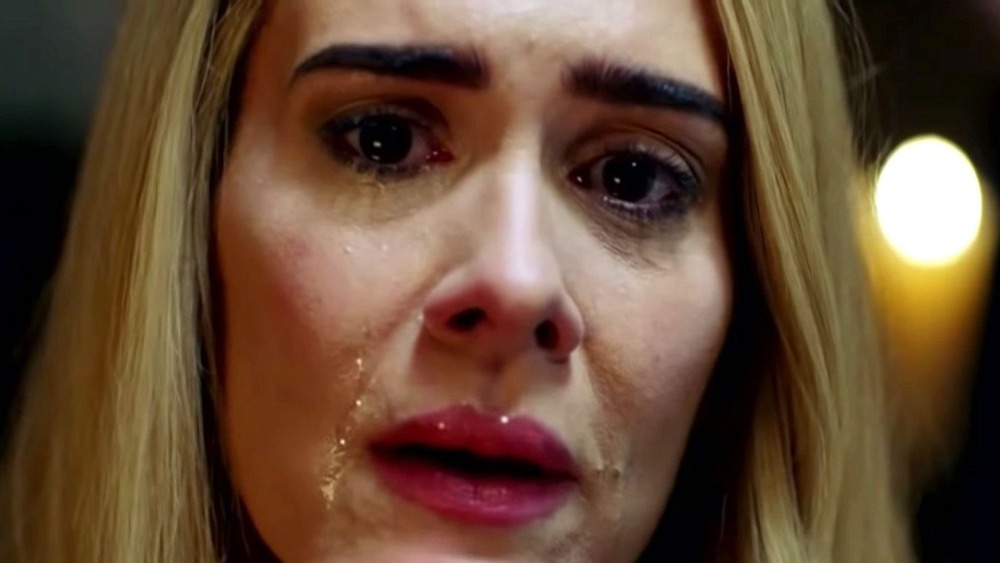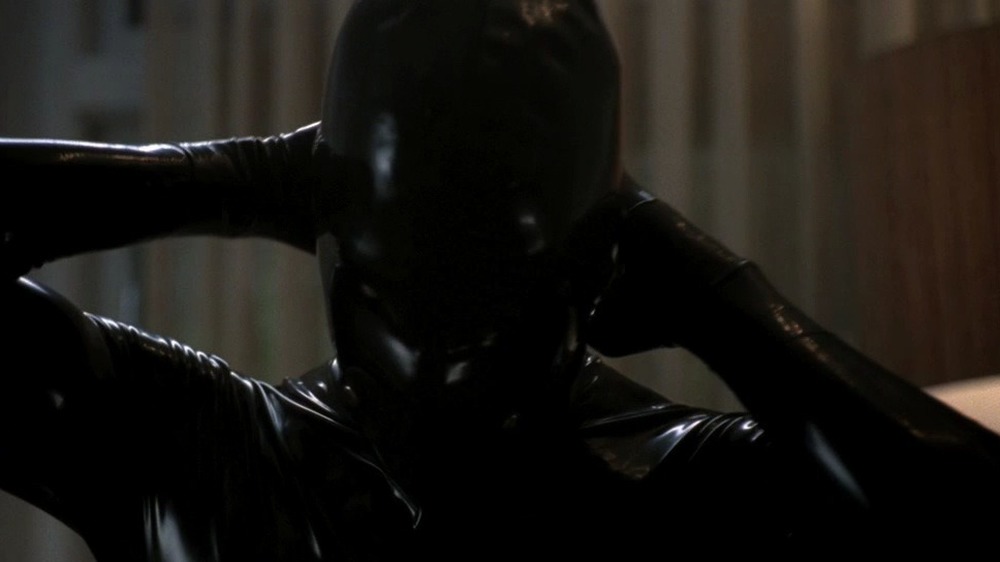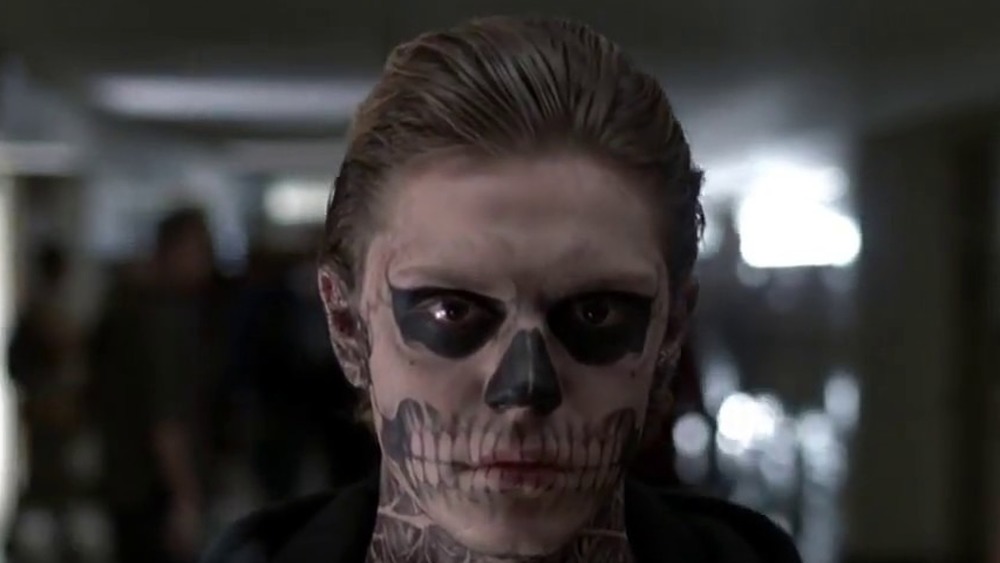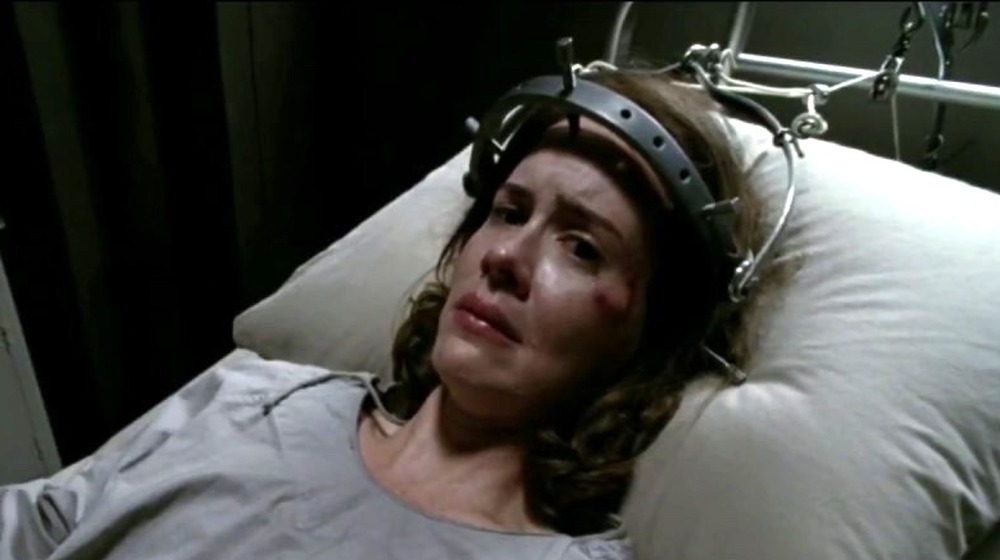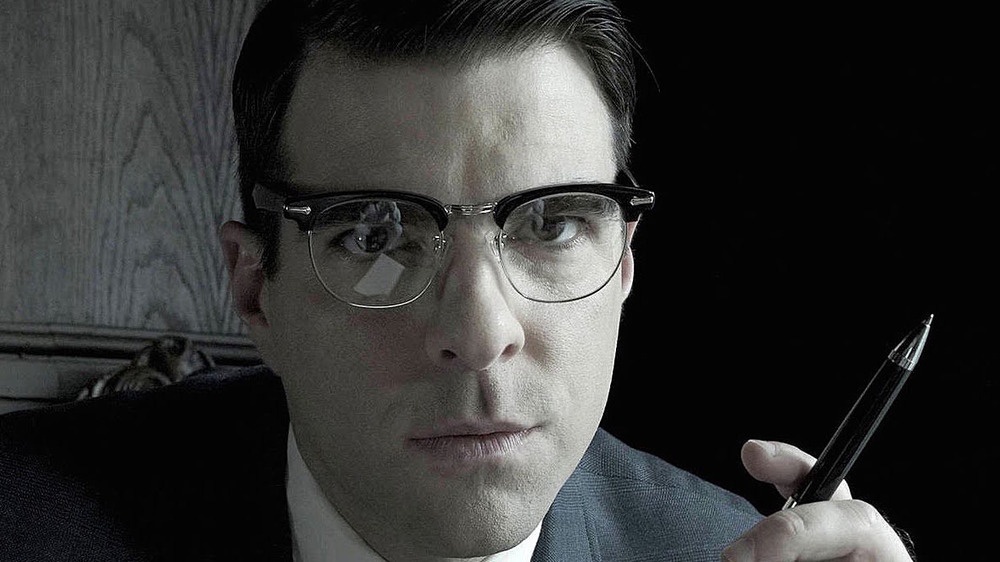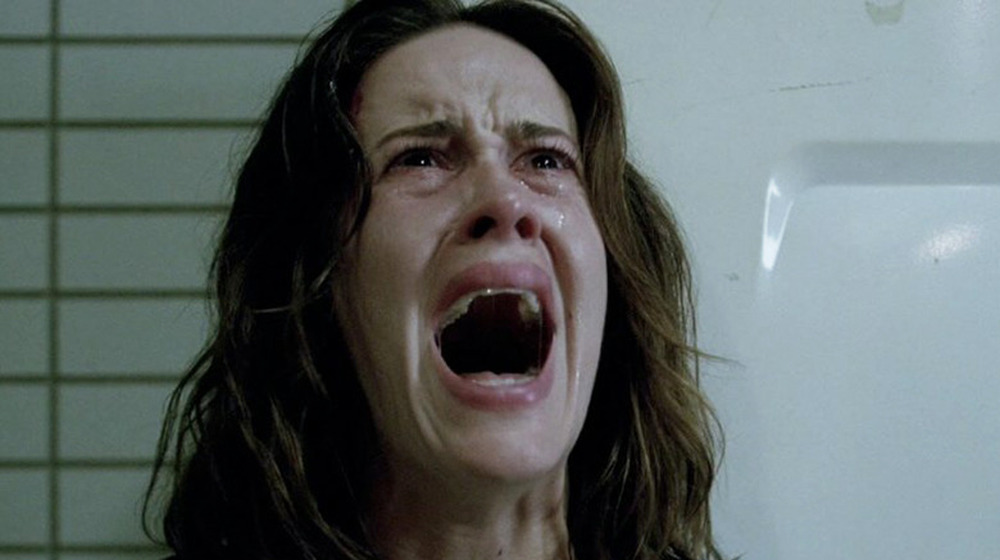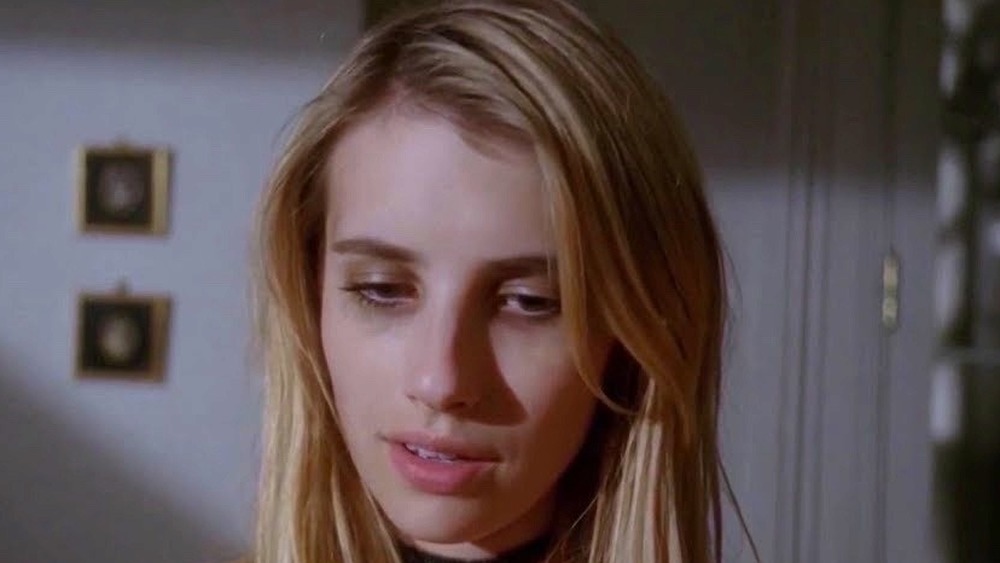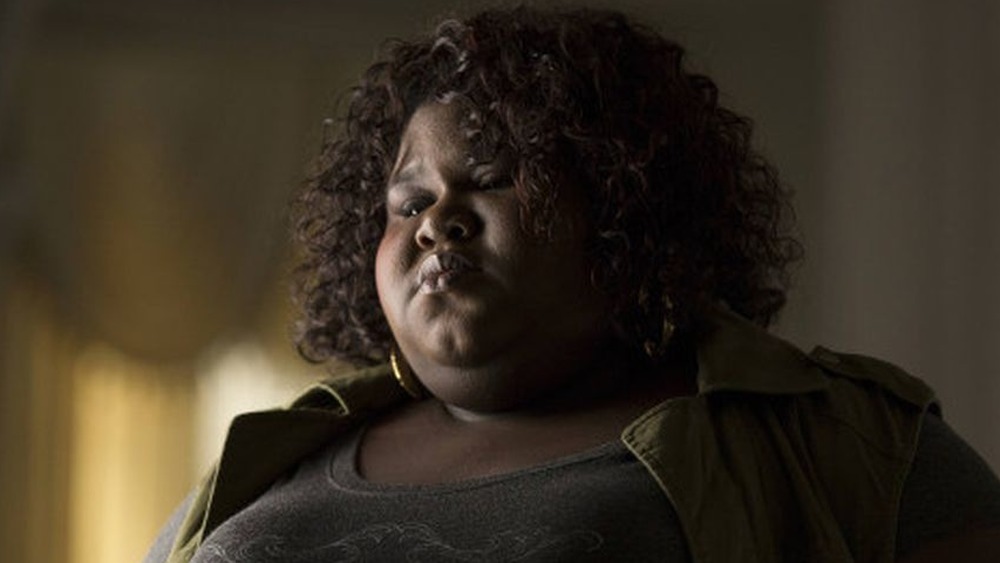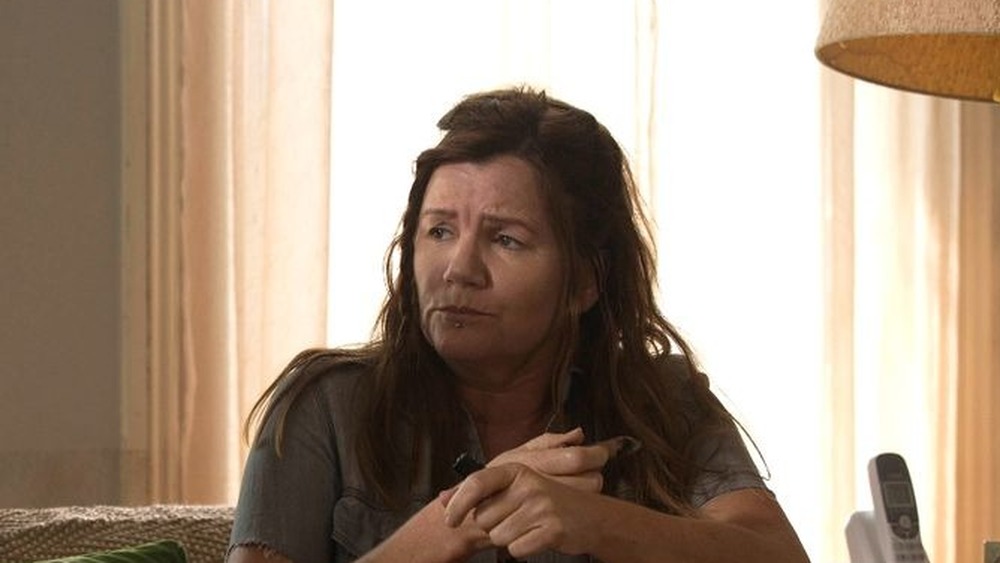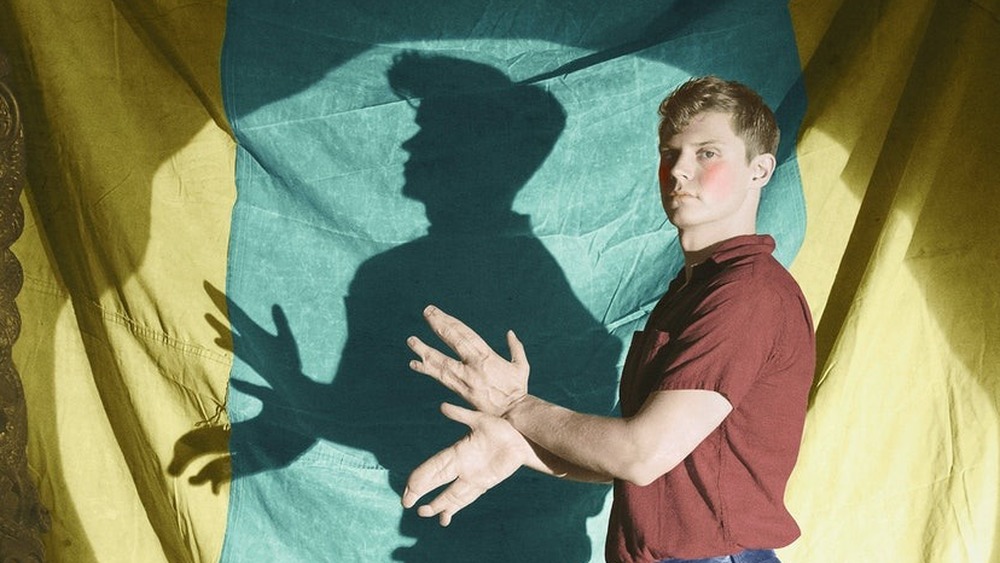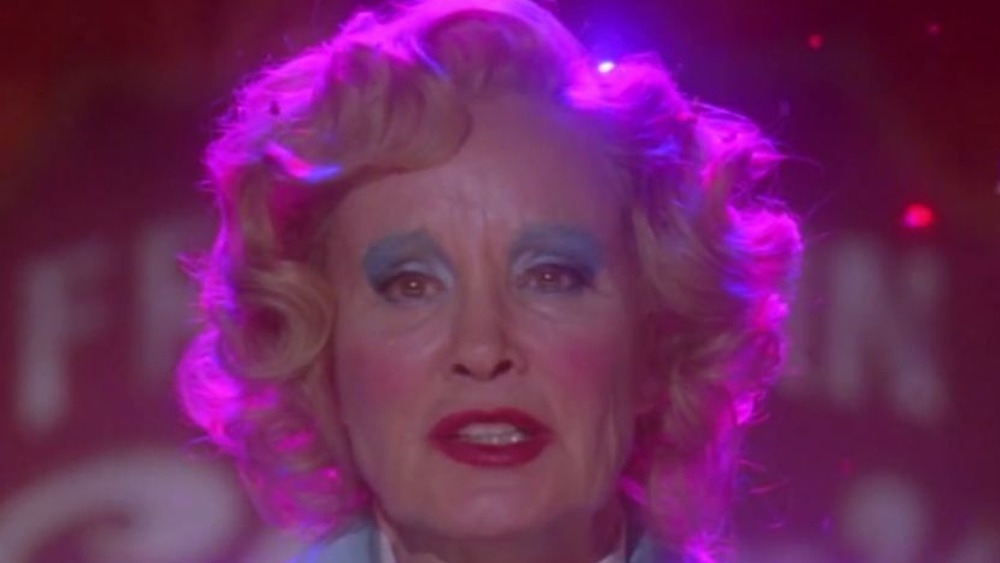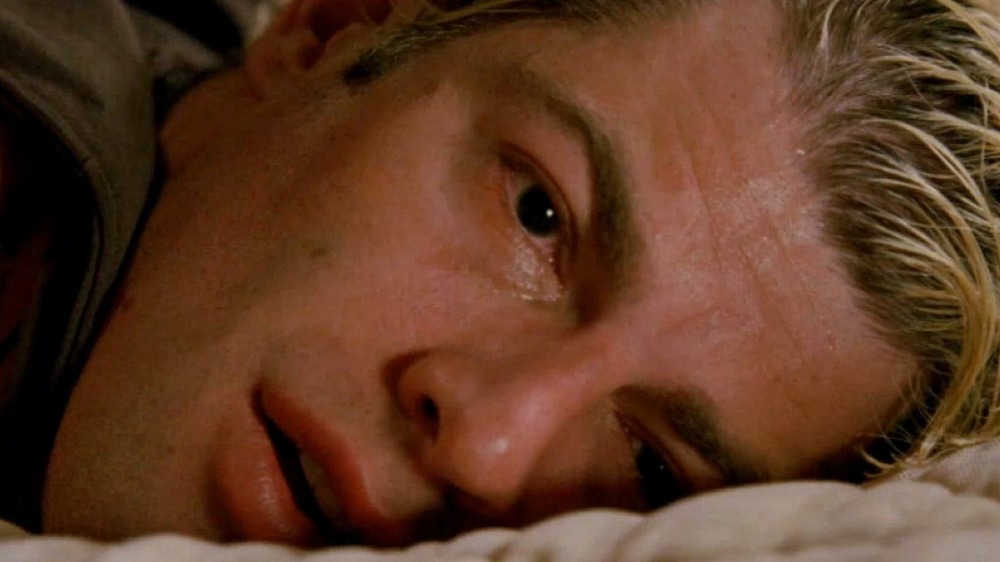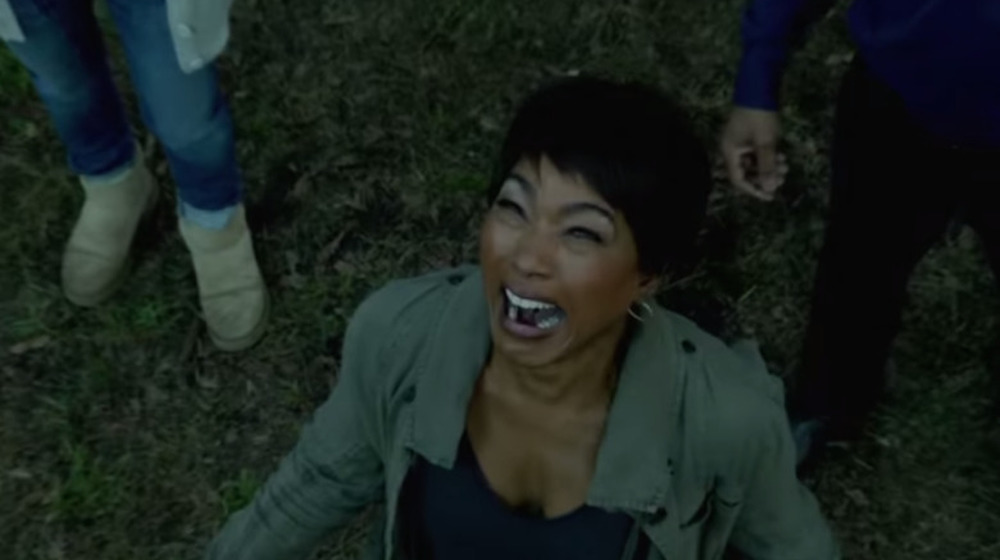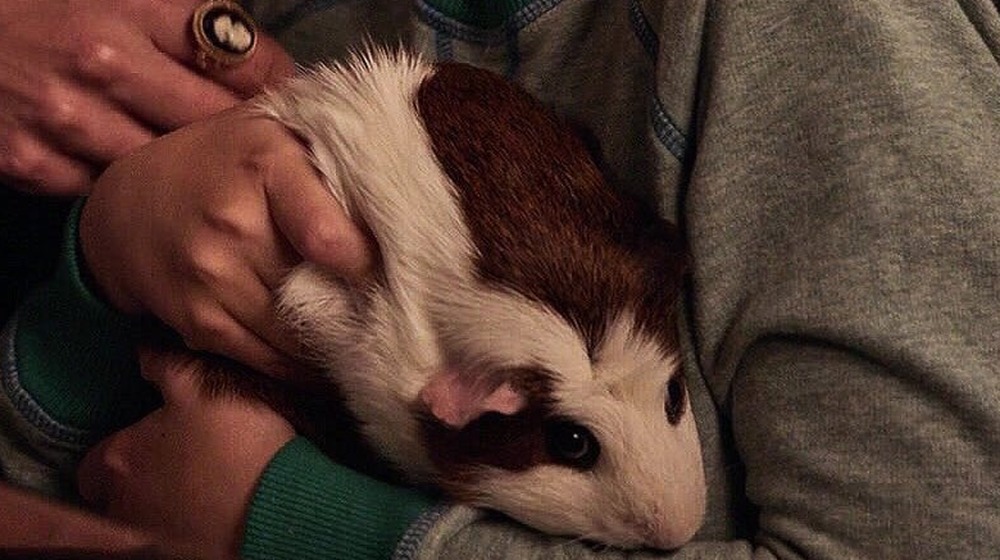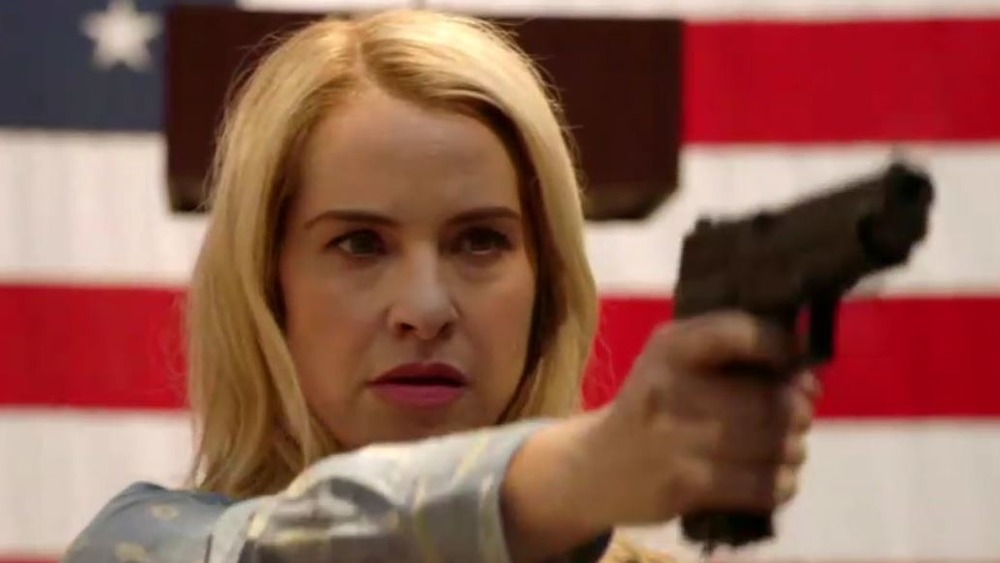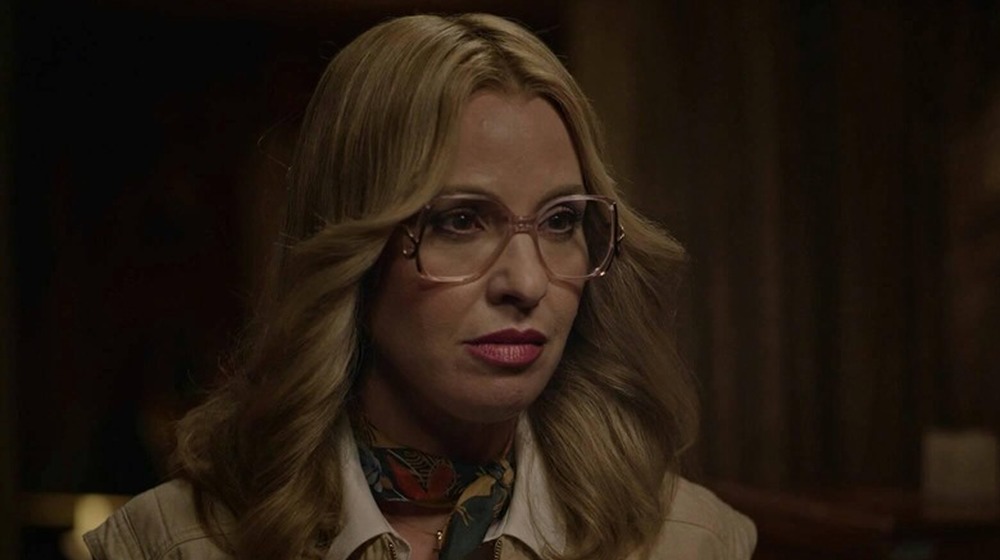American Horror Story Moments That Went Too Far
American Horror Story has been giving us the creeps for years now. Since 2011, perennial franchise favorites like Jessica Lange, Sarah Paulson, and Evan Peters have been horrifying us alongside a slew of seasonal guests like Lady Gaga and Kathy Bates. Nine seasons and countless unforgettable monsters and messed-up moments later, AHS has become showrunner Ryan Murphy's longest-running series to date. Fans of horror come to the show for its disturbing imagery and nightmare-inducing monsters. But AHS is also a show filled with emotional trauma — and it's fair to say that more than once over the years, the show has crossed the line of what we all thought was possible to air on FX.
From depictions of mass murder to multiple varieties of intense violence, AHS has run the gamut of ways to push the envelope. Sometimes the show doesn't use these moments to push the story forward and presents them simply for shock value. Other times, the depictions are just a bit too detailed to stomach. Whatever it might be, American Horror Story has been crossing that line since day one — and here's a look at some of the moments that went too far.
Vivien encounters the Rubber Man
Right off the bat, the very first episode of American Horror Story's first season contains one of the show's most uncomfortable scenes. Not long after Vivien (Connie Britton) and Ben Harmon (Dylan McDermott) move into the titular Murder House, everything starts to go slightly awry in the show's first of many disturbing sexual encounters. While the audience knows the person Vivien is having sex with in that rubber suit is not just Ben in a kinky mood, she has no idea. She's enjoying it, which makes the whole thing feel that much more icky. It's not the most explicit assault in AHS history — not even close — but the scene remains a disturbing depiction of psychological manipulation.
The darker twist on the sequence comes much later in the season when it's revealed that the ghost of Tate (Evan Peters) is actually the inhabitant of the Rubber Man suit. Any diehard fan can remember just how important this scene ends up being to Murder House as it plants the seed — quite literally, in fact — for the mind-blowing finale.
Tate's flashback
In the show's first truly controversial moment, American Horror Story proved it wants to shock the fans. This happened during the show's first depiction of an extreme act of mass violence. A few episodes into Murder House, we are shown a flashback in which Tate commits mass murder by shooting and killing students at a high school. This explicit depiction of a school shooting was pretty controversial and is still hard to go back to and watch to this day.
Due to how prevalent school shootings are in United States it becomes difficult to justify any depiction of this type of mass shooting in the media. Certain films that focus on this as the core subject — like Gus Van Sant's movie Elephant — can avoid criticism, but for the most part any scene of mass shooting can be seen as glorification, if not outright triggering, by members of the audience. Murder House is so jam packed with stories and characters that this one-off backstory moment isn't nearly enough to give the proper context to make the scene anything more than shock value.
Lana's aversion therapy
Asylum is arguably the darkest and most disturbing of the AHS seasons, but it just might be the fan favorite for the same reason. Briarcliff Manor is a haunting name for anyone who has watched this run. Still, even Asylum had some moments that went too far. Way too far.
The first of these moments is not as graphic as the others, but it is just as chilling. After Lana (Sarah Paulson) is committed to the asylum for her homosexuality, she is forced into therapy with Dr. Thredson (Zaracary Quinto). In an attempt to make her "homosexual urges" go away, Thredson gives Lana aversion therapy in an attempt to convert her.
The most excessive scene of all is one when he forces Lana to touch herself while looking at a naked man standing next to her. It's a very direct portrayal of emotional abuse through the guise of help, and is all in all a traumatic sequence that could have been a little shorter — or just not in there at all. The point is still made without the inclusion of this scene.
Trapped in Thredson's basement
In one of the darkest moments of the entire show, Dr. Thredson reveals he's the killer Bloody Face, but not before he traps Lana in his basement. Worse still, she's tied up next to the corpse of her dead girlfriend Wendy, who was captured, tortured, and killed by Bloody Face earlier in the season.
The trauma and terror of being trapped with a serial killer and a corpse is unfortunately only the tip of this grisly iceberg. The worst and most gut-wrenching part of it all is thankfully not shown. It definitely would not have been allowed on FX, at least not based on the way Thredson describes it to Lana.
"You will begin by kissing her cold, dead lips," he says. What he implies will happen with her and Wendy's corpse after the kiss they will share is unspeakable — and remains haunting to this day.
Lana's terminated pregnancy
As AHS often proves, the sweet taste of revenge comes with dire consequences. In the case of Asylum, everyone suffers by the end — even the villain.
After Thredson assaults Lana when she's captured, she becomes pregnant with his child. Late in the season, with Thredson finally backed into a corner, Lana threatens to give herself an abortion unless he does exactly as she asks. Not wanting his child to die, Thredson obeys. Lana questions Thredson and he proceeds to tell the chilling story of how he murdered a woman and what he did to her after. This story of this horrific act is only the first half of this shocking scene.
After he finishes, Lana reveals that she has put Kit (Evan Peters) up to the task of secretly recording the confession. She then tells Thredson she already performed the abortion the day before — and we're shown this in a graphic flashback. However, as anyone who finished the season knows, this was an unsuccessful attempt. The scene still lives among the most disturbing ever committed to television.
The frat house
Once again, AHS starts off a season on perhaps too bold of a foot. In the very first episode of Coven, the titular young witches attend a frat party. What happens came as no shock to anyone familiar with frat movie tropes — or the history of Greek life and sexual assault in the United States — but the depiction is indeed unnecessarily graphic.
During the party, Madison (Emma Roberts) is given a drugged drink and taken to a bedroom where she is assaulted by a group of the frat members. The scene of the assault itself is very explicit and frankly hard to watch. Even for a show that frequently deals with sexual violence, this graphic depiction of gang rape is taking things far in a situation where implication could just have easily done the trick. Telling, not showing, would have honestly been the better route to go on this one.
The Minotaur sex scene
Queenie (Gabourey Sidibe) is a fan favorite from Coven. She carries herself with confidence and is genuinely funny and charming, but this is American Horror Story we're talking about, and everybody has their baggage. In one of Coven's most infamous scenes, we see Queenie has gone a bit too far in overcompensating for her trauma.
In the third episode of the season, "The Replacements," Queenie encounters a minotaur — a bull's head on a man's body — sent by Marie Laveau (Angela Bassett) to exact her revenge on Madame Lalaurie (Kathy Bates). But when Queenie and the minotaur meet, she isn't afraid of him. Knowing his tragic backstory, Queenie doesn't feel fear but empathizes with him. She can relate to the way he's been treated and used by others because of his appearance.
The two become intimate — and it ends shockingly fast, when the minotaur covers Queenie's mouth with his hand before the show cuts to the next scene. This is a little graphic, but more importantly, it's simply unnecessary for the character. For a season that deals explicitly with issues of race, the way this scene is handled can be interpreted as equating the desires of a physically imposing Black woman to those of a beast.
Kyle's mom attempts to assault him
The scene immediately after the minotaur might not be as infamous, but is yet another example of AHS firing on its most grotesque cylinders. After being brought back from the dead — albeit in zombie form — Kyle (Tate) returns to his mother. Their relationship was not the healthiest, let's just say, and now that he's come back to life (but not quite fully alive), things go downhill quickly.
Kyle's strange behavior agitates his mother. After a bout of frustration she breaks down, saying "no one knows you like I do" as she begins to grind on him and attempt to sexually assault him. In response, Kyle grabs a trophy from his dresser and beats her to death with it.
This is an example of an AHS scene that feels like it was included purely for shock value. It doesn't do a whole lot for the overall arc of the season or its characters, and is clearly there to push boundaries in a way that isn't especially meaningful.
Jimmy's hands
An early shock from Freak Show that basically goes nowhere involves Jimmy (Evan Peters), and is a recurring theme of the season premiere. Jimmy is one of the freaks who performs with Fräulein Elsa's Cabinet of Curiosities. He was born with ectrodactyly, a hand malformation that gave him the performing name "Lobster Boy." In this first episode, we see Jimmy has a special lucrative use for his cleft hands that goes beyond performing in the show.
As it turns out, Jimmy's side hustle sees him making extra money as a sex worker, pleasuring women with his special ability. It is purely consensual and nonviolent, but something about it ends up being a super unsettling pure shock value moment from American Horror Story. Jimmy's side hustle has little to do with the arc of his character or where Freak Show ultimately goes in the end. If nothing else, the season definitely lives up to its title.
Elsa's past
The mysterious leader of the Cabinet of Curiosities finally has her backstory revealed four episodes into Freak Show — and boy, is it a grizzly one. The origin of Elsa's (Jessica Lange) amputated legs is revealed in the second half of the "Edward Mordrake" two-part episode. A payoff to one of the biggest mysteries set up in AHS history, this reveal may have gone a bit too far in terms of its gruesomeness.
Despite the trauma she has endured, Elsa finally opens up and tells her story to Edward Mordrake (Wes Bentley). This flashback shows that she used to work as a dominatrix in a German brothel — where one day she was drugged, captured and forced to participate in an early snuff film. It is then revealed that her legs were cut with a chainsaw on camera for the purpose of the, uh, "storyline." The scene is one of the most intense acts of pure violence in the history of American Horror Story and won't be forgotten by fans of the show — or Jessica Lange — anytime soon.
The addiction demon and Gabriel
In typical AHS fashion, the first episode of the Hotel season is yet again a gritty tone-setter. This season gets off to a violent start with the appearance of the now infamous addiction demon, who is without a doubt the scariest monster to ever appear in the show — and if you've been reading up to this point you know that's saying something.
The grotesque flesh-like monster looks like something straight out of a Silent Hill game. It makes its first appearance crawling out of a bed in the episode's opening scene. But it's only later that we see the true terror. Not long after, heroin user Gabriel (Max Greenfield) checks into the hotel for a night. Before he even gets a chance to settle in and get high, he is violently raped by the demon. All of this happens in the season's opening 30 minutes.
The addiction demon scene contains the most explicit sexual violence that's ever appeared in AHS. No matter which way you slice it, it's a horrific scene that has lingered in the mind of any viewer tenacious enough to witness it. And let's not forget about the drill.
Audrey and Monet eat Lee
The sixth season of AHS went for more of a meta fiction slow burn approach to horror, which led to not as many disgusting moments as seasons past. Still, this incredibly gross Roanoke scene combines torture and cannibalism for a moment that definitively went too far.
In the second half of the season, Lee (Adina Porter), Audrey (Sarah Paulson), and Monet (Angela Bassett) are all kidnapped by the Polk family. They are then taken back to the Polk farm and tied up. There, Audrey and Monet are forced to eat human flesh. But not just any human flesh, as we see as the Polks peel the skin from Lee's leg and feed it to her friends.
It's truly nauseating to watch and you can't help but feel bad for how much this show has put Sarah Paulson through at this point. Even before Roanoke aired, the cannibalism trope already felt a bit played out — going all in on it the way this does feels more than a little excessive.
Poor Mr. Guinea
One of the absolute peak gross-out moments in AHS history happened early in the show's seventh season, Cult. The victim this time was not human, but a helpless animal. And the worst part of all (well, aside from the way it happened) is how the pet was taken from a child mere minutes after his onscreen debut.
In episode 3 of Cult, Ally's (Sarah Paulson) clown-obsessed son Oz is given a guinea pig by their suspicious new neighbors the Wiltons, played by comedians Billy Eichner and Leslie Grossman. Actually, Mr. Guinea (as Oz soon names it) just arrives in their house; it's only later they're told who dropped it off. Violence against cute animals is rarely cool and never feels fun to watch. But that didn't stop Ryan Murphy from sticking Mr. Guinea in a microwave in one of the most unnecessarily gruesome moments of American Horror Story. While it isn't shown who does it, the creepiest part of all is that the Wiltons are the number one suspects.
The assassination
This moment went so far that by the time it aired it was already edited down from what was originally intended to be shown. The infamous assassination and mass shooting scene that bookends the episode "Mid-Western Assassin," especially its shocking ending, is one of the most controversial moments in the history of American Horror Story.
In the episode's opening we see the aftermath of a mass shooting at a political rally. Kai (Evan Peters) is assassinated, dozens are dead, and Ally is shown with a gun in her hand. The rest of the episode sets up returning to this scene and explains what's really happening. But in the end, the entire shooting is shown — and it's a terrifying scene that hits very close to home for a show called American Horror Story. Perhaps a little too close.
Mass shootings are a sensitive issue, especially in the context of political violence. This is not the first time AHS has gone there, but this scene (and the entire episode's premise) feels like it's ripped from the headlines simply for the sake of the ripping.
The death of Margaret Booth
After a run of episodes that are mostly free of grotesque moments, American Horror Story's most recent season ended with a bang — or more of a chop and then a churn. There's no denying that Margaret's (Leslie Grossman) death at the end of 1984 was a satisfying moment for many fans — after an entire season of unraveling her evil murder plot, everyone got to team up in the finale and put an end to her for good. In AHS, what goes around comes around
Her final fate at the hands of the ghosts of the counselors she killed and trapped at Camp Redwood was earned, for sure. But decapitation on top of being thrown into a wood chipper limb by limb? That's a bit excessive. What ultimately redeems it is that even through its gruesomeness, 1984 still manages to achieve a happy ending that's all too rare for an installment of AHS. Whatever comes next is certain to be a downer.
